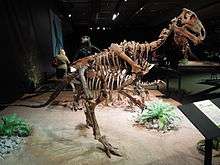Probactrosaurus
| Probactrosaurus Temporal range: Late Cretaceous, 96–88 Ma | |
|---|---|
 | |
| Mounted casts | |
| Scientific classification | |
| Kingdom: | Animalia |
| Phylum: | Chordata |
| Class: | Sauropsida |
| Superorder: | Dinosauria |
| Order: | Ornithischia |
| Suborder: | Cerapoda |
| Infraorder: | Ornithopoda |
| Superfamily: | Hadrosauroidea |
| Genus: | Probactrosaurus |
| Binomial name | |
| Probactrosaurus gobiensis Rozhdestvensky, 1966 | |
Probactrosaurus (meaning "before Bactrosaurus") is an early herbivorous hadrosauroid iguanodont dinosaur. It lived in China during the Late Cretaceous period. It is often known as the Asian Iguanodon.
Discovery and history


In 1959 and 1960 a Soviet-Chinese expedition uncovered the remains of a euornithopod in Inner-Mongolia near Maortu. The type species is Probactrosaurus gobiensis, described and named by A. K. Rozhdestvensky in 1966. The generic name refers to Rozhdestvensky's hypothesis that Probactrosaurus would be the direct ancestor of Bactrosaurus, a notion today discarded. The specific name refers to the Gobi desert. The holotype specimen, PIN 2232/1, a partial skeleton with skull, was found in layers of the Dashuigou Formation. Another partial skeleton was found, PIN 2232-10, along with numerous other fragments.[1]
In 1966 Rozhdestvensky also named a second species, Probactrosaurus alashanicus, based on fragmentary material. Its specific name refers to the Alxa League. In 2002 David Bruce Norman published a revision of the genus, in which he reported the holotype specimen of P. alshanicus, the back of a skull, had been lost after being dispatched from Moscow to Beijing. He concluded that the species was a synonym of P. gobiensis.[2]
In 1997 Lü Junchang named a third species, Probactrosaurus mazongshanensis, based on holotype IVPP V.11333 found in 1992. The specific name refers to the Mazong Shan region.[3] Today, this form is seen as more closely related to Equijubus and Altirhinus rather than to P. gobiensis and is therefore commonly referred to as "Probactrosaurus" mazongshanensis.
Probactrosaurus was a herbivorous dinosaur. In 2010 Gregory S. Paul estimated the length at 5.5 metres (18 feet), the weight at one tonne.[4] It was lightly built, with relatively long and slender arms and hands and only a small thumb spike. It had a narrow snout, an elongated lower jaw and tooth batteries, each consisting of a superimposed double row of flattened cheek teeth; a third row of replacement teeth was incipient. Probably predominantly quadrupedal, it shared some common features with the later duck-billed dinosaurs.[5]
Probactrosaurus was originally assigned by Rozhdestvenky to the Iguanodontidae. Today it is seen as a basal member of the Hadrosauroidea, relatively closely related to the Hadrosauridae.
See also
References
- ↑ A.K. Rozhdestvensky, 1966, "Novye igyanodonti ie tsentrallinoy Asii. Phillogeneticheskye y taksonomicheskye veaimoothoshenia poednich Iguanodontidae y rannich Hadrosauridae", Paleontologicheskii Zhurnal 1966(3): 103-116
- ↑ Norman D.B., 2002, "On Asian ornithopods (Dinosauria: Ornithischia). 4. Probactrosaurus Rozhdestvensky, 1966", Zoological Journal of the Linnean Society 136(1): 113-144
- ↑ Lü J., 1997, "A new Iguanodontidae (Probactrosaurus mazongshanensis sp. nov.) from Mazongshan area, Gansu Province, China", In: Z. Dong (ed.), Sino-Japanese Silk Road Dinosaur Expedition. China Ocean Press, Beijing pp. 27-47
- ↑ Paul, G.S., 2010, The Princeton Field Guide to Dinosaurs, Princeton University Press p. 292
- ↑ Palmer, D., ed. (1999). The Marshall Illustrated Encyclopedia of Dinosaurs and Prehistoric Animals. London: Marshall Editions. p. 145. ISBN 1-84028-152-9.
| Wikimedia Commons has media related to Probactrosaurus. |
